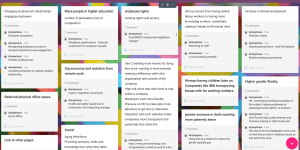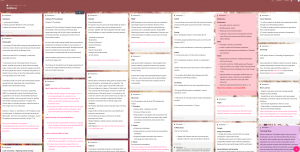What is Padlet?
Padlet is a web-based whiteboard or bulletin board where students and teachers can collaborate, reflect, share text, images, video and links in a secure online location. Padlet allows users to create a hidden wall with a custom URL, that you can then embed into Brightspace if you want to, and as the creator of a Padlet you can also moderate posts, remove posts, and generally manage the board whenever you like.
I use it frequently and the response from my students is positive, indeed in the last round of MUSE I received a number of comments like this one “Keep using padlet, we love it”.
Students can access Padlet using their phones, tablets or laptops either before they come to class as ‘flipped classroom’ preparation for a seminar discussion, or in class, or in the lecture theatre – and they can continue to access, review or continue working on the board after the session.
If you haven’t used it before, you may be interested to see some examples, so I thought I would start the discussion by sharing a couple of my boards and explaining how I have been using it.
In-class brainstorming
Here students were considering social changes that are impacting HR departments:
For UGs allowing them to post anonymously is well-received. Students came up with loads of content here, the Padlet page just scrolls down as needed.

In a lecture, do you give definitions of key terms or theories?
I always used to do this on my PowerPoint slides and then I tried using Padlet in my lecture, and instead of giving the students a definition I ask them to work in pairs, find a definition they like and then post it onto the Padlet – they just access the URL and click the + button and then they type their content into the box.
I’ve done this with smaller groups but also in lectures with 250 people, from Level 4 to PG. With larger groups, I have listed 3 terms on my screen and split the group into 3 blocks giving each block one term each. Again, I’ve asked them to work in pairs, but then to reduce the number of entries onto the Padlet, although there is no limit, I’ve asked them to work with the pair behind them to agree which definition they prefer and then load that up. Within KG01, we’ve had some real fun with the activity, so we’ve worked out odds and evens with a crazy type of Mexican wave. We start with the first row raising their arms and they’re the odds (opportunity for a cheesy joke about not wanting to cause offense – always gets a laugh), then they drop their arms, next row raises their arms, you’re evens, and down, next row up, odds etc.
Like my board below, what you will probably find is that your students post a wide range of sources, from ~pedia type resources, to regulatory or professional bodies and hopefully some key theorists – and the referencing will be inconsistent, or non-existent. This gives you a great opportunity to have a conversation about the need to cite sources when something is taken from the internet, of the importance of BU Harvard referencing, and an analysis of the quality of sources and encouraging students to use alternative strategies rather than ‘lazy googling’.
Students find the activity really helpful, it brings the topic of sources and references alive; and having looked for their own definition their initial interest in the topic is enhanced.

Flipping the classroom to facilitate greater depth of in-class discussion
Students were asked to research companies and find one that they thought did good CSR activity and post some details to the board and come to class ready to discuss the ideas. Again, having completed the research themselves they are more invested in the examples they have identified, and it is normally much easier to get them talking about their company in the seminar. As all the work is captured digitally and embedded to Brightspace, students have a great range of case study examples they can then research further for their assignments.

Once again, the group came up with loads of good stuff and this Padlet goes on below this screenshot.
These are just a few examples, I have more, and I’m sure that across BU we must have loads so if you have used Padlet, please share.
If you think your colleagues could benefit from seeing what you’ve been doing, perhaps you could also write something up, or record a video about it and share through the blog.
If you haven’t used Padlet before, here are some User Instructions on how to set up and share a Padlet, and how to embed it into Brightspace
Padlet_Instructions_and_Brightspace
I hope this helps you try Padlet, if you haven’t yet,
Rebecca Hindley
Lecturer, The Business School.









I wanted to reiterate how Padlet is amazing in f2f setting and online.
I do the following exercise with students in class when teaching strategy: I ask them to go away and research the lingerie industry, a group of students are split to use different models. So when they come back to the seminar, I then split them into two large groups, but each group has a student who used one of the models listed to study the industry. Then each group is asked to either vote for Invest in the industry or Not. All of the discussions and arguments are documented via Padlet – a fantastic way of engaging students in the class.
Online students, I teach love Padlet because it instantly connects everyone as they are in class sharing ideas. They comment on each other’s ideas and overall love various formats of data and media Padlet enables to incorporate: links, files, images, text etc.
I strongly recommend using Padlet as it is something children in primary schools are using. Hence, students who will be coming to us in future are familiar with the tool.
Regards,
Elvira